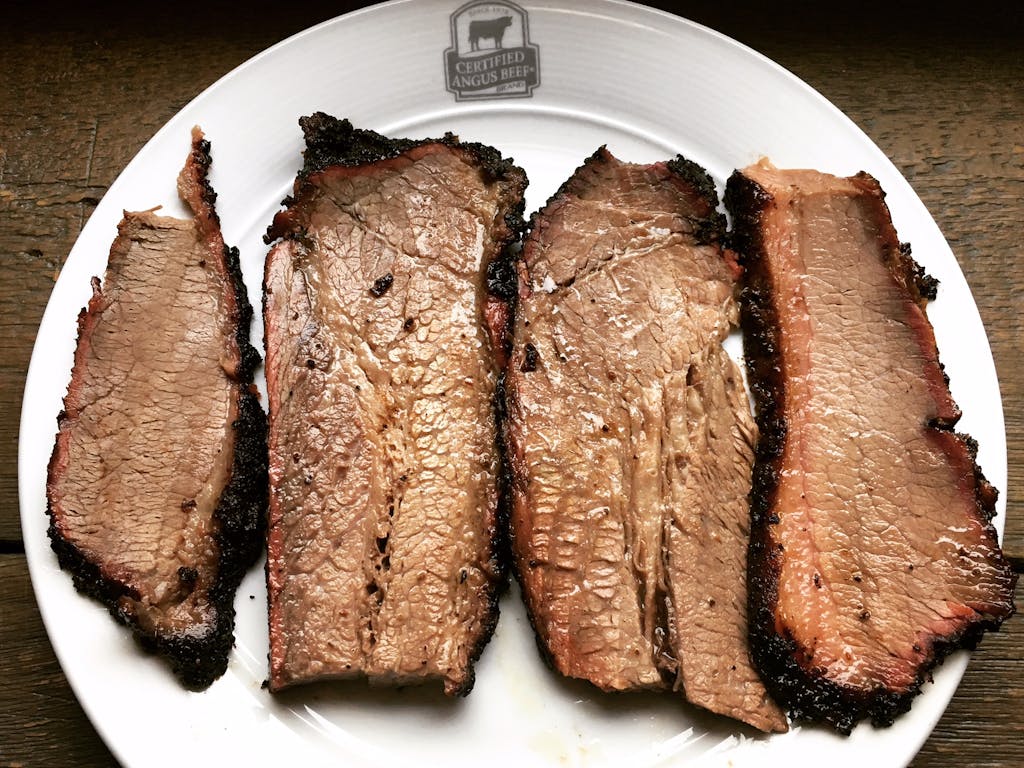Earlier this year, I smoked what I had dubbed the Yearling—a brisket that was packaged in 2015 and spent about thirteen months in a friend’s garage refrigerator. Although it didn’t end my life-long streak of never having fallen ill because of smoked meat, the experiment ultimately provided mixed results. It seemed miraculous that a brisket wouldn’t be completely ravaged by wanton bacteria at that point in its refrigerated life span, but the age made it taste a bit off. Still, it was very tender for a Select brisket, so it got me interested in the possible improvements that prolonged wet-aging could have on smoked brisket.
I used the folks at Certified Angus Beef (CAB) as a resource for the article because they’d done some experimentation with prolonged wet-aging on beef. After eating my own antique brisket, I talked with Chef Michael Ollier and meat scientist Diana Clark, who was stunned that the Yearling hadn’t spoiled during storage. Ollier was more interested in the possibilities of enhancing tenderness through wet-aging. It was January, and they agreed to host the next iteration in the experiment. A couple CAB (upper Choice grade) briskets sitting in their cooler would be held there until June.

If you forget about a cut of cryovaced beef in your refrigerator, it sounds a lot better to tell your family that wet-aged ribeye is on the menu instead of a few old steaks, but it’s basically the same thing. Wet-aging really just means allowing the meat to sit in the heavy, plastic, vacuum-sealed cryovac bag it was originally packaged in. Far more studies have been done about the effects of dry-aging on beef, but Texas A&M is testing the effects of wet-aging on smoked brisket in a yet unreleased study, but the furthest out they go is 35 days. Of the published studies that I’ve found, 28 days is the upper limit. I wanted to go way beyond that, and CAB was happy to oblige (I survived a year-old brisket, after all).
“It didn’t smell bad at all,” Clark said as we stood next to the mobile Southern Pride smoker outside of CAB’s culinary center in Wooster, Ohio. For a second opinion, she made her husband take a whiff of the unpacked briskets to confirm her initial sniff test. “Even when I cut into it, it looked pretty,” she said as she opened the smoker doors. Hickory and apple wood smoke cleared to reveal the nearly done briskets.

A total of four briskets were on the smoker. Two at six months old and two more, used as controls, that had been in the cooler for 21 days, which is the target for many pitmasters’ packaged briskets and the CAB recommended timeline for their beef cuts. Each of the briskets were seasoned with Kosher salt and coarse black pepper before the long, steady smoke. One old and new brisket was kept whole, and another one of each was separated into the point and flat before smoking, which would allow us to compare the flavor of the seam fat.
There’s something reassuring about eating January brisket in June when you’re around a bunch of meat scientists who are willing to do the same. CAB’s Dr. Phil Bass looked on as Clark sliced the briskets. He had found increased tenderness in 60 day wet-aged strip loins and ribeyes in the past, and was hopeful about the outcome of our experiment. This was supposed to be a blind tasting, but the differences between the old and new briskets revealed themselves rather starkly after they were cut. The gray six-month brisket seemed to dry out further before our eyes. The 21-day brisket was well-smoked and looked appetizingly moist. The same thing, though to a lesser degree happened when we sliced into the second pair of briskets.

Clark had recorded their weight throughout the process. She expected more moisture loss, or purge, over the prolonged storage of the six-month-old brisket, but there was only a negligible difference from the purge of the 21-day brisket. The cooking, however, was a different story. The yield from pre-cooked weight to post-cooked weight (all of the briskets were untrimmed) was 62 percent to 65 percent for the 21-day aged briskets. For the six-month old briskets, the yield sunk to 50 percent. In a fourteen-pound brisket, that’s the difference of a couple of pounds of lost water weight. Looking at the numbers alone, the dryness of the older brisket wouldn’t have been a surprise. Bass assumed that “the cells were compromised during the aging,” reducing their ability to hold into the moisture.

In evaluating the flavor, none in the group preferred the aged brisket, which is putting it lightly. Ollier went as far as calling it “offensive.” Instead of the rich, umami flavor of parmesan you might expect from a dry-aged steak, this funk tended toward sour, and it was deep within the meat. Even with all the bark removed, the funk was there, lingering in the aftertaste. There was also a noted difference in moisture. I call it “tooth squeak” when dry meat (think grandma’s overcooked Thanksgiving turkey breast) lets out a sound as it sticks to your molars while chewing. The older brisket had it. As for improved tenderness, it was hard to tell. As Bass pointed out, “When the moisture isn’t there, you’re likely to perceive less tenderness.”
Simply put, there wasn’t much to love about the six-month old brisket. But the tasting did get Bass thinking about another direction. If the sweet spot for smoked brisket is a 21-day wet-age, what if the sweeter spot is 7 or 14 days? That’ll be worked out in future experiments. But for now, my research in the field of prolonged wet-aging on smoked brisket will cease due to lack of positive feedback. Six months in a bag does not a better brisket make.
- More About:
- Brisket







